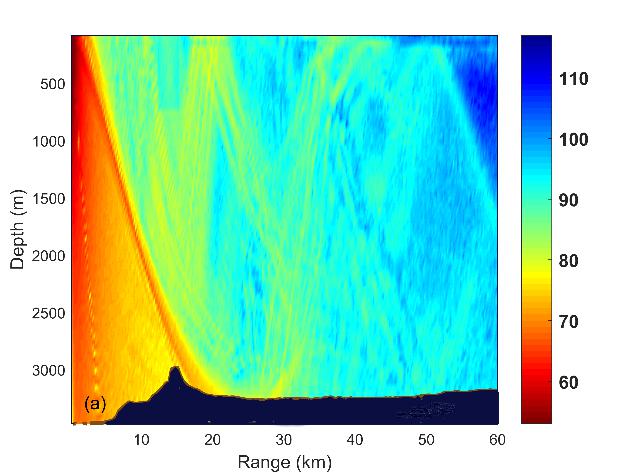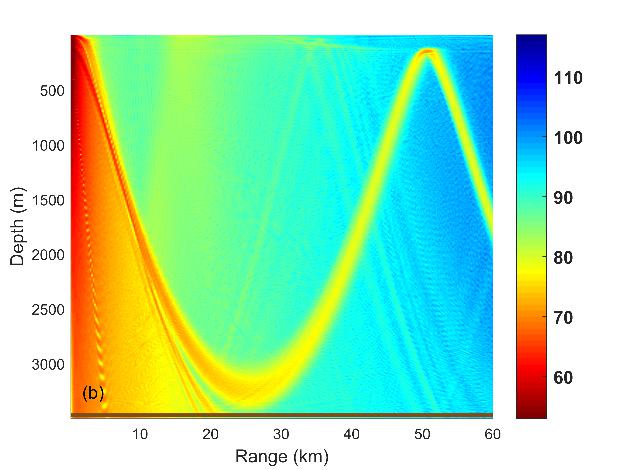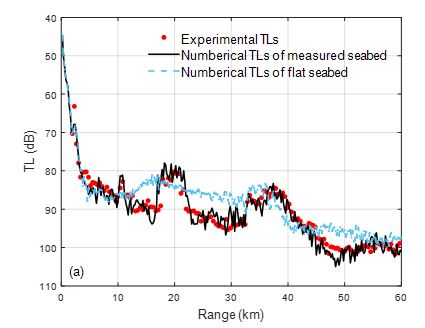There are widespread landforms in deep ocean, such as submarine slopes, seamounts, uneven bottoms and submarine canyons. Compared with the deep-water flat bottom, the bathymetry variation has a significant influence on sound propagation in the context of an incomplete sound channel.
Many researchers have studied the effects of acoustic propagation in range-dependent underwater environments. However, experimental finding of the seafloor reflection convergence zone has been unreported so far.
Researchers from the Institute of Acoustics (IOA) of the Chinese Academy of Sciences carried out an experiment in the South China Sea in 2018. Based on the sound propagation data collected during the experiment, the researchers revealed the causes of the phenomena of the sound convergence zones formed by the reflection from the sea bottom in deep water.
Recently, the paper entitled “Characteristics of convergence zone formed by bottom reflection in deep water” was published online in Acta Physica Sinica.
The observed experiment phenomenon is quite different from the convergence phenomenon in the deep sound channel, which is also referred to as the Sound Fixing and Ranging (SOFAR) channel. Researchers employed the numerical analysis based on the parabolic equations combined with ray theory to calculate the arrival time of the pulse arrival structure as well as the eigenrays and explained the formation mechanism of the seafloor reflection convergence zone in deep water under a complex seafloor environment.
The experimental and numerical results showed that the changes in seabed topography greatly influenced the formation and propagation characteristics of the seafloor reflection convergence zone within the range of the direct-arrival sound area. When the sea depth gradually decreases as the distance increases, the convergence zone under the SOFAR channel is destroyed.
When the source and receiver are located at the same depth, the gain of the second convergence zone is higher than that of the first convergence zone, which is caused by the decrease in the bottom reflection energy loss and the increase in the number of arriving rays. In the first convergence zone, as the receiving depth increases, the arrival structure tends to become more complicated and the multipath effect becomes more obvious.
Convergence zones of the sound field are formed by variations of the sound speed profile and water depth, which are important acoustic characteristics in deep water. The study result is meaningful for the performance analysis of sonar in complex deep-water environments.


Figure 1. Numerical TLs results from RAM-PE model. (a) Real bathymetry, (b) flat bottom. (Image by IOA)


Figure 2. Comparison of experimental TLs and numerical TLs, where(a)-(b) for the receivers at 85 m and 145 m, respectively. (Image by IOA)
Funding for this research came from the National Natural Science Foundation of China (No. 11434012, 41561144006 and 11874061).
Reference:
ZHANG Peng, LI Zhenglin, WU Lixin, ZHANG Renhe, QIN Jixing. Characteristics of convergence zone formed by bottom reflection in deep water. Acta Physica Sinica, 2019, 68(1): 014301. DOI: 10.7498/aps.68.20181761.
Contact:
ZHOU Wenjia
Institute of Acoustics, Chinese Academy of Sciences, 100190 Beijing, China
E-mail: media@mail.ioa.ac.cn


